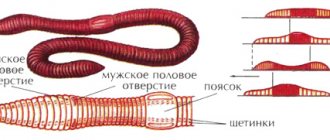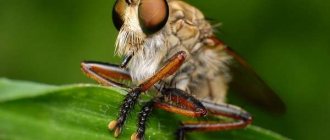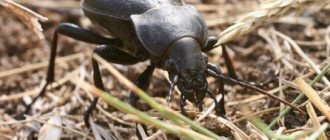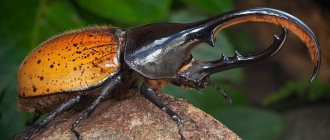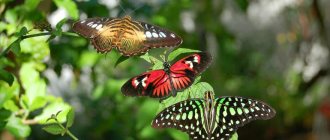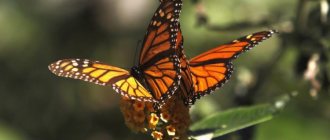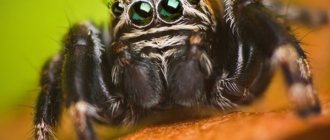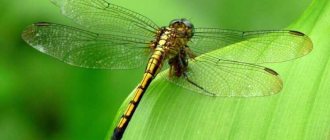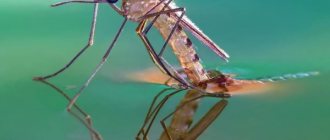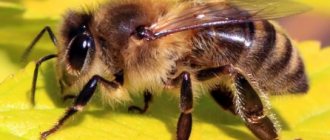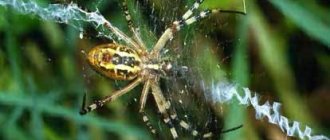Class Insects (Insecta)
Class Insects (Insecta). Structural features, digestion, respiratory and excretory systems, sensory organs and representatives
The most numerous class among the animal kingdom. There are over 1 million species (more than the species of plants and other animals combined). They live mainly on land, in the soil, and fly in the air. Some species have adapted to life in water, a parasitic lifestyle. Sizes range from a few millimeters to 25 cm (the wingspan of some species of tropical butterflies). The lifespan of adult insects is short (approximately several months). At the same time, some species can live for several years (female ants and termites - up to 20 years). The branch of zoology that studies insects is called entomology (from the Greek entomon - insect and logos - science). Possible ancestors of insects are centipedes.
The cuticle of insects is covered with a thin layer of fat-like substance that prevents the body from losing moisture. On the surface of the cuticle there are movable hairs, scales, and bristles.
The body consists of a head, chest and abdomen. On the head there are a pair of segmented antennae, oral organs (a pair of upper jaws, a pair of lower jaws, a lower lip), a pair of complex compound eyes, and maybe 1 - 3 simple ocelli. The area between the compound eyes is called the forehead . On the sides under the eyes there are cheeks . The back surface of the head is called the occiput . The head and thoracic region are movably connected.
The chest consists of three segments. They have 3 pairs of limbs that extend from each thoracic segment and are movably attached. The types of limbs depend on the lifestyle: walking, running (in beetles), hock (in grasshoppers), digging (in mole crickets), swimming (in the diving beetle). On the last segment of the legs there are claws, and in some species there are also suckers.
Many insects (adults only) have wings (a fold of skin filled with hemolymph) that are attached to the second or second and third segments of the thorax. The wings have developed transverse and longitudinal veins that form a supporting frame. The trachea and nerves pass through the middle of the veins. The shape and structure of the wings are varied. In many species, the first pair of wings is transformed into hard elytra that protect the rear membranous, often transparent wings from damage. In the order Diptera only the first pair of wings is developed. The second is modified into club-shaped appendages, which provide a certain frequency of wing flaps, stabilize the insect’s balance in flight and are called halteres . There are two known types of flight in insects: flapping and soaring. Flight is ensured by the coordinated work of the pectoral and wing muscles. By quickly working their wings, some insects are able to hover in the air (flies, dragonflies, etc.).
The abdomen consists of several segments (4 – 10) and an anal plate. It houses most of the internal organs. Each segment has a pair of spiracles. There are no limbs. In some species they are modified into an ovipositor, sting, etc. The paired appendages of the last abdominal segment are called cerci.
Features of eggs
We looked at how insects reproduce. Now we will find out what is peculiar about their development at each of the phases.
The eggs of representatives of the class are covered with two shells and have a wide variety of shapes, colors and sizes. The most common forms found in nature are:
For example, the eggs of butterflies and flies are most often oval, while those of bedbugs are in the shape of an almost regular ball. Most often they are laid in small groups - oviposition, but in some species they can also be laid singly.
Digestive system of insects
Class Insects (Insecta). Types of mouthparts: gnawing type (grasshopper), sucking type (butterfly) and licking type (fly)
The nature of their diet is varied (predators, parasites, herbivores, etc.). The structure of the oral apparatus is associated with the type of food and lifestyle. There are several types of mouthparts.
The gnawing mouthparts are considered the most ancient (characteristic of primitive insects) and are common in insects that feed on solid plant or animal food (beetles, cockroaches, orthoptera, etc.). On top, the oral opening of such an apparatus is covered by an unpaired plate (upper lip), on the sides there are paired upper and lower jaws, and on the bottom – an unpaired lower lip. The upper lip is formed by a fold of the cuticle. The upper jaws are represented by plates with teeth on the inside. The lower jaws consist of two segments. On the upper segment there is a pair of ruminant lobes and a mandibular dissected palp (the organ of touch and taste). The lower lip was formed by the fusion of the lower jaws, consists of two segments and has a pair of lower labial palps and two pairs of ruminant lobes.
The piercing-sucking apparatus is characteristic of insects (bugs, mosquitoes, etc.) that feed on liquid food: plant juice, tissue, animal blood.
A sucking mouthpart in the form of a long tube of two halves is found in butterflies that feed on the juice of fruits and the nectar of flowers. Flies have a peculiar oral apparatus with a fleshy lower lip - licking (modified sucking).
Gnawing-licking mouthparts are found in Hymenoptera (bees, wasps, etc.). These are mouthparts that have extended into a proboscis to suck up nectar. At the same time, the upper jaws remained almost unchanged (reduced ruminant teeth) and are used for the structure of cells. Sometimes adult insects do not feed (mulberry moths), their oral organs do not function and may be reduced.
The digestive system consists of the oral cavity, pharynx, esophagus, large crop, muscular stomach (in insects that feed on solid food, the walls are thick with chitinous teeth or plates for grinding food), midgut, hindgut, which ends in the anus.
The ducts of the salivary glands open into the oral cavity. Their secretion moistens and partially dissolves solid food. In bees, the secretion of the salivary glands turns into honey when mixed with nectar. In the caterpillars of butterflies, hymenoptera larvae and some other insects, the salivary glands are modified into silk-secreting or spinning glands. Silk thread is used to build a cocoon, protective formations, etc.
Worker bees feed the larvae of the future queen with the secretion of the pharyngeal glands.
The inside of the midgut is lined with glandular epithelium, which secretes digestive juice. Insects do not have a liver. Some insects, like spiders, are capable of extraintestinal digestion (ladybug larvae, diving beetles, etc.).
Parthenogenesis
Let's consider which insects are capable of reproducing parthenogenetically. These are stick insects, some types of beetles, scale insects, aphids, many types of wasps, ants and bees.
Capable of such reproduction:
- Males, in this case, the phenomenon is called arrhenotoky.
- Females, we are talking about thelytoky.
- Both of them are amphitokia.
It is customary to distinguish several types of parthenogenesis, the differences of which are presented in the table.
Varieties of parthenogenesis
It is partial in nature and occurs only under the influence of external factors or under a special condition of the female.
A striking example is the reproduction of aphids. There is an alternation of generations: virgin and bisexual; in this case, the offspring of a female who has not received fertilization consists of females for a long time, but the growing season always ends with amphitokyy or arrhenotoky.
Most often observed in closed ground conditions, under optimal external conditions, in the absence of the need to proceed to reproduction with the participation of both sexes.
This method of reproduction has adaptive significance; the process involves an individual of only one sex, which helps insects survive even in unfavorable external conditions.
Respiratory system of insects
They breathe using the trachea. They branch and entwine all organs, even entering individual cells in the form of tracheoles. stigmas open outwards - openings on the sides of the abdomen and chest. In the anterior part of the abdomen and chest, the trachea expands and forms air sacs. Gas exchange occurs through the trachea (oxygen is absorbed, carbon dioxide is removed), and water vapor is removed. Breathing occurs due to the rhythmic contraction and stretching of the lateral and longitudinal muscles of the abdomen. The larvae of some insects breathe using tracheal gills (dragonflies, mayflies). These are formations on the surface of the body or in the hindgut, which have the appearance of petals with branched trachea in the middle. The tracheal system is closed (there are no spiracles). Oxygen enters the trachea from the gills.
Methods
There are five main ways in which insects reproduce. Information about them is presented in table form.
Description of insect reproduction methods
Its brief description
The development of the embryo occurs in the body of the mother, and a larva or prepupa is born.
Some types of flies and gadflies
Individuals of both sexes participate in the process, mating and egg laying occur. A large number of insects reproduce in this way.
Reproduction is at the larval stage; larvae develop in her body, which eat the mother’s body to escape. The method is typical for Coleoptera or Hemiptera and often alternates with gamogenesis.
Some types of gall midges
Virgin reproduction, without fertilization.
Honeybee, some Hymenoptera
Otherwise, this method is called multi-embryonic reproduction; it occurs at the egg stage. This method is typical for Hymenoptera parasites: a parasite egg is laid in the embryo of the host egg.
These are the main methods of reproduction of insects found in nature.
Nervous system of insects
It consists of the subpharyngeal (formed by the fusion of three ganglia) and suprapharyngeal ganglia, connected by peripharyngeal connectives, and the ventral nerve chain. The subpharyngeal node innervates the oral organs and the anterior intestine. The ventral chain is formed by three thoracic ganglia and eight abdominal ones. In some highly organized insects, adjacent nodes of the ventral nerve chain merge by combining the thoracic ganglia into one large node. The abdominal nodes can merge into 2 - 3 or 1 large node (in flies, lamellar beetles). The thoracic ganglia regulate the functioning of the legs and wings.
The suprapharyngeal ganglion forms a special development. It forms the brain, which includes three sections: anterior, middle and posterior. Innervates the antennae and eyes (it has a pair of large optic lobes on the sides). stalked or mushroom-shaped are very well developed . They are believed to be responsible for the behavior of insects.
The complex structure of the nervous system causes complex behavior.
Signs of infection with cutaneous myiasis
There are several signs that may indicate that you are infected with this disease:
- a subcutaneous formation appears with itching, a feeling of heat, which can grow. Sometimes there is a feeling of movement in it
One of the signs of infection may be a subcutaneous formation with itching. The appearance of a tumor that can change its location
- the resulting tumor can change location
- severe weakness, elevated temperature
- allergic manifestations, most often urticaria.
Sense Organs of Insects
On the head there is 1 pair of antennae (organs of smell and touch). Various structure of the antennae: comb-shaped, club-shaped, filamentous, lamellar, bristle-shaped, serrated, etc. The organ of vision is complex (compounded) eyes, sometimes there are simple ones (1 – 3). Each compound eye consists of a large number of facets (several thousand). Most insects do not perceive red color, but they perceive ultraviolet radiation well. Simple eyes (not capable of perceiving images) react to the degree of illumination and can perceive polarized light. Insect larvae with complete metamorphosis have lateral eyes (from one to several pairs). Each such eye can perceive images of objects. The body and limbs are covered with hairs and scales, which are receptors for taste, touch, etc. Some insects have a hearing organ (in grasshoppers, on the front pair of legs, etc.).
Diagnosis and treatment
Moreover, the disease caused by the larvae of the human gadfly has a name - dermatobiasis. It is characterized by the formation of painful nodes under the skin around the parasite. Such bumps can become inflamed. Often pus comes out of them.
At the same time, the human body reacts sharply to the “stranger,” which leads to the appearance of various allergic reactions. The larva itself also secretes the most harmful substance, hypodermotoxin. As a result, symptoms such as:
- fever;
- vomiting (or attacks of nausea);
- weakness (usually with dizziness);
- muscle pain;
- skin redness;
- itching;
- swelling;
- tearing (if the larvae get into the eyes or mucous membranes).
Of course, if parasites are detected in a timely manner and removed, no life-threatening complications arise. All the unpleasant reactions described above are quickly eliminated by promptly removing the parasite, taking medications correctly and using special ointments.
The main thing is to timely diagnose the disease caused by the vital activity of the larvae. To do this, a blood test is performed to determine the amount of antibodies. If they do not correspond to the norm, and the patient himself has been in places where gadflies are active, then, most likely, an infection has actually occurred.
Sometimes a simple visual examination is sufficient, during which purulent abscesses with a hole are identified on the skin. The doctor can only examine them to find parasites.
Insect Reproduction
Types of insect development. Complete transformation (development with metamorphosis) and incomplete transformation (development without metamorphosis)
They reproduce only sexually (with or without fertilization). Reproductive organs are developed only in adult insects (imago). Insects are dioecious. In many species, sexual dimorphism is well expressed (beetle - deer, butterflies, etc.). The genital organs are located in the abdomen. In females they are represented by tubular ovaries, oviducts, accessory gonads, and spermatic receptacle. At the end of the abdomen, females have an ovipositor for laying eggs. In some insects of the order Hymenoptera, it is turned into a sting with a duct of a poisonous gland inside.
In males, the reproductive system is represented by a pair of testes, vas deferens, vas deferens, and accessory reproductive organs. At the end of the abdomen the copulatory apparatus may be developed. Fertilization is predominantly internal.
There is only one genital opening, since the ducts of the gonads merge. Some insects are characterized by mating behavior (competition for a female, etc.).
Most insects lay eggs, sometimes they are viviparous (they give birth to live larvae - aphids, gadflies, etc.). Eggs are covered with a thick shell and contain a supply of nutrients (yolk) inside. They are laid by females singly or in groups on different surfaces, in soil, water or in animals, etc. The insects are very prolific (bees lay up to 1.5 million eggs every day for 10 - 12 years; termite queen - over 30 thousand eggs) . They can have several generations per year (depending on the species and living conditions).
Development with transformation (complete and incomplete). Stages of incomplete transformation : egg - larva - adult insect ( imago ). Characteristic of cockroaches, bedbugs, lice, orthoptera, etc. Insect larvae with incomplete metamorphosis are similar in appearance to an adult insect, but are smaller in size (after each molt they become more and more similar to an adult), primarily live where adults live, and feed on the same food. food. Sometimes the larvae live in a different environment (dragonflies, etc.), then they have certain adaptations and differ somewhat from adult insects.
Stages of complete transformation : egg - larva - pupa - adult insect (imago). Characteristic of Lepidoptera, Hardy Ptera, Hymenoptera, Diptera, etc. The larva is neither in appearance nor in its way of life similar to an adult insect. The larvae of such insects never have compound eyes, the limbs are mostly absent or underdeveloped, the mouthparts differ from those of adults, and they feed on different foods (which reduces competition with adults). The larvae of some species may have special larval organs (silk-secreting glands of a caterpillar, etc.). The pupa is motionless and does not feed. In it, the larval tissues are completely destroyed and new ones, characteristic of an adult insect, are formed. Only the nervous system, the rudiments of the gonads and special structures - imaginal discs , due to which the organs of an adult insect are formed, are not destroyed.
The development of some insects can be very short, and in some species it can last for several years (chafer beetle, etc.).
The insect class is divided into approximately 30 orders.
Development
Insects begin their life with eggs, the appearance and shape of which are very diverse. Eggs are also laid in different ways: one at a time, in groups, openly, immersed in the substrate or covered in various ways. The variety of egg shapes and means of laying them even makes it possible to identify certain groups of insects with precision down to genus and species. The embryonic development of insects occurs in the egg, resulting in the formation of a larva. The larva emerges from the egg shell in one way or another. She eats and grows, but only grows when she molts.
Incomplete development: locusts
The transformation of a larva into an adult is called metamorphosis. There are two main types of development - incomplete and complete. When metamorphosis is incomplete, the eggs hatch into larvae that look like smaller copies of adults. The only difference is that they do not have a reproductive system and only the rudiments of wings. During molts, they grow and, bypassing the pupal stage, turn into adults. With complete metamorphosis, the larva first turns into a pupa, and only then into an adult. There are three main types of pupae:
- open or free
- covered, covered with a hard shell
- hidden, covered with hardened, not shed skin, which acts as a false cocoon.
Before turning into a pupa, the larva can form a cocoon of silk, like silkworms; The pupae of daytime butterflies are often not covered with anything. Other insects, on the eve of pupation, look for some kind of shelter: cracks under the bark, rolled up leaves, or bury themselves in the ground. Many insects have immobile pupae. Mosquito pupae swim well, and lacewing pupae crawl. Under the shell of the pupa, complex transformations occur, as a result of which the organs of the imago are formed.
Insect Orders
Types of insect development. Development of insects with incomplete transformation: egg - larva - adult insect (imago). Development of insects with complete transformation: egg - larva - pupa - adult insect (imago)
Insects with incomplete metamorphosis
- Order Orthoptera (Orthoptera). Representatives: green, gray grasshoppers, locusts, mole crickets and others.
- Order Cockroaches (Blattoptera). Representatives: black cockroach, red cockroach or Prussian cockroach, Madagascar hissing cockroach, American cockroach and others.
- Order Termites (Isoptera). Representatives: Mediterranean termite or pest , etc.
- Order Lice (Anoplura). Representatives: head louse, body louse , etc.
- Order Hemiptera or Bugs (Hemiptera). Representatives: turtle bugs, pine subcortical bug , etc.
- Order Homoptera (Homoptera). Representatives: mountain cicada , etc.
- Order of Dragonflies (Odonata). Representatives: rocker dragonflies, beauty dragonflies , etc.
Insects with complete metamorphosis
- Order Beetles or Hardwings (Coleoptera). Representatives: ladybug, ground beetle, May beetle, Colorado potato beetle, stag beetle, swimming beetle , etc.
- Order Lepidoptera or Butterflies . Representatives: swallowtail, cabbage, silkworm , etc.
- Order Hymenoptera (Hymenoptera). Representatives: bee, wasp, bumblebee, ant , etc.
- Order Diptera (Diptera). whiskered dipterans include mosquitoes, midges, mosquitoes , etc. Short-whiskered dipterans include flies, gadflies , etc.
- Order Fleas (Aphaniptera). Representatives: human flea, rat flea , etc.
Meaning of Insects
The diversity and importance of insects
They are an important link in natural biocenoses. They surpass all other animals in biomass.
Parasites and predatory insects are regulators of the species they feed on. They are food for many animals. Insects pollinate plants, of which 150 cultivated species are known. Some types of insects are of sanitary importance, destroying animal corpses, plant remains, animal feces, and forming soil (dung beetles, burying beetles).
Class Insects. Pests of grain crops: Bread beetle, Cereal fly, Ground beetle, Thrips and Cereal aphid
They are pests of agricultural plants and food (locusts, beetles, larvae of some moths, etc.). Some types of insects secrete valuable substances (lye, carmine). Beneficial insects (predators or parasites) – destroyers of pests (riders, ground beetles, ladybugs, lacewings, etc.).
Honey, royal jelly, bee venom, and glue are obtained from the honey bee. Wax is widely used in industry (metallurgy, chemical production, electrical engineering). Silk is obtained from the silkworm.
Many types of insects are pests of agricultural and forest crops. Dangerous pests of cultivated plants include about 300 species (chafer beetle, mole cricket, beet weevil, ringed silkworm, gypsy moth, fall armyworm, cabbage cutworm, pea weevil, Colorado potato beetle, etc.). About 200 species of insects damage human food supplies (peas and beans - grain beetles, flour - mill moth caterpillar, grain - grain moth, some weevils, etc.). Wooden products, buildings, and plants are damaged by termites. Fur products, wool products - house moths, leather products - carpet beetles.
Among insects there are parasites of animals and humans (fleas, bedbugs), which can be carriers of serious diseases (lice - the causative agent of typhus and relapsing fever, fleas - the causative agent of plague, house flies - the causative agent of typhoid fever, dysentery, etc., flies tse - the causative agent of sleeping sickness, malarial mosquitoes - falciparum plasmodium (the causative agent of malaria), etc.).
